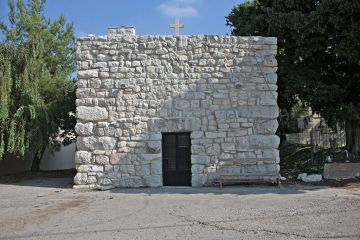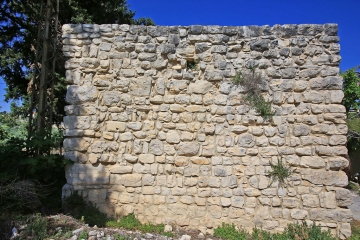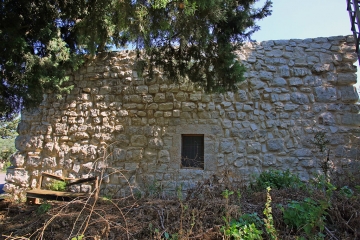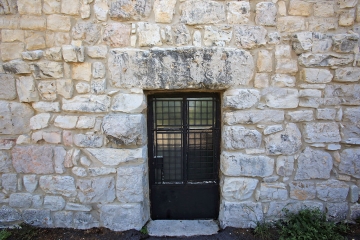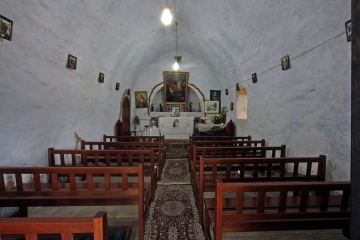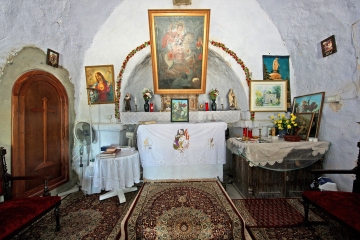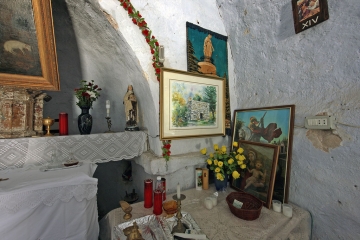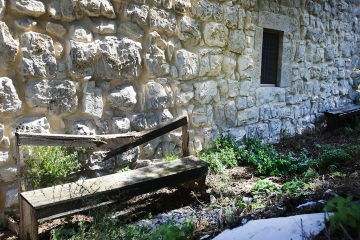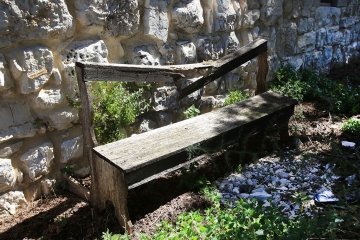دير مار جرجس – الكفر
اكتسب دير مار جرجس ـ الكَفر، وهي تعني "القرية"، صِفَة المَقرّ البطريركيّ من سكن البطريرك دانيال الشاماتي فيه، وهو الذي نقل المقرَّ البطريركيّ إلى هذا الدير، والوحيد من البطاركة الذي سكن فيه.
يقول البطريرك اسطفان الدويهي في "سِلسِلته البطريركية" أنه "بعد وفاة البطريرك إرميا العمشيتي، عَقَبَه البطريرك دانيال من شامات التابعة بلاد جبيل، فَسَكَن أولاً في كفيفان، ثم في دير مار قوفريان، ثم في كفرحي في دير يوحنّا مارون، وكان ذلك سنة 1541 (لليونان) كما يَذكَر يوحنا بن يعقوب البشرّاوي. وقد ذُكر في الفنقيط الذي حَظي به في كنيسة مار سابا في قرية بشرّاي بِخَط يوحنا المذكور انه في سنة 1547 لليونان كان قاطناً في دير مار جرجس - الكفر من عمل جبيل".
فإذا كان هذا البطريرك ساكناً سنة 1541 في كفرحي وسنة 1547 في الكفر، أي بعد ذلك بسِتّ سنوات، فيكون انتقاله قد حصل من كفرحي إلى الكَفر. وهذا ما يؤيده فيه كتاب "المَجمَع اللبناني" في صفحته 431 اذ يقول: "دانيال الشاماتي، خليفة البطريرك إرميا العمشيتي، نقل المقرَّ البطريركيّ من دير القديس مارون في كفرحي إلى دير القديس جرجس في الكفر من أبرشية جبيل، وكان ذلك سنة 1230 م".
ولكنَّ الدويهي يعود فيناقِض نفسه عندما يقول، في "سِلسِلته" أيضاً: "انتقل الكرسيّ البطريركيّ من سيّدة يانوح، حيث كان جالساً على السدَّة البطريركية إرميا العمشيتي، إلى دير القدّيسَين قبريانوس ويوستينا في كفيفان، وهناك جلس على الكرسيّ البطريركيّ دانيال الشاماتي ونقل الكرسيّ إلى دير مار جرجس- الكفر قضاء جبيل، ومنه إلى دير القديس مارون في كفرحي". ففي ذلك تناقض مزدوج مع قوله السابق، حيث قال ان الانتقال كان من كفرحي إلى الكفر ثم هو يقول هنا ان الانتقال حصل، على العكس، من الكفر إلى كفرحي. اما التناقض الثاني فهو في قوله مرَّةً أن البطريرك الشاماتي انتقل من كفيفان إلى دير مار قوفريان ثم إلى كفرحي، وفي قوله مرةً أخرى أن الشاماتي جَلَس في دير كفيفان ومِنه نَقل الكرسيّ إلى دير مار جرجس ـ الكفر، أي أنه لم يَمُرّ في دير مار قوفريان. كما نلفت النظر إلى ان دير قوفريان هذا لم يَرِد ذكره كمسكن لأحد البطاركة إلا في هذا المَقطع الذي أوردناه، إلا اذا كان المقصود بدير قوفريان دير قبريانوس ويوستينا نفسه القائم في كفيفان.
كذلك تَتَضارَب المعلومات حول مكان انتخاب دانيال الشاماتي بطريركاً، إذ يذكر بعضها أنه انتُخب في دير سيّدة ايليج (ميفوق) بينما تَذكُر معلومات أخرى انه انتُخب في يانوح.
وفي المعلومة الأولى أن انتقاله إلى كفيفان كان من إيليج لا من يانوح، إذ تقول: "خَلَفَ البطريرك إرميا العمشيتي البطريرك دانيال الشاماتي، وبعد انتخابه في دير سيّدة إيليج، انتقل إلى دير كفيفان، ومنه إلى دير كفرحي"، وبِحَسب الدويهي أنه كان سنة 1236 مُقيماً في دير مار جرجس - الكفر" (التي يجب ان تطابق السنة 1547 اليونانية).
وتوضِح هذه المعلومة سبب انتقاله من إيليج فتقول: "سَكَن في دير سيّدة إيليج، لكنه اضَطَّر إلى مغادرته بسبب الحروب والفتن المملوكية، فانتقل أولاً إلى دير مار قبريانوس كفيفان، ثم إلى دير مار يوحنا مارون في كفرحي والى دير مار جرجس الكفر في بلاد جبيل".
إذن فإن دير مار جرجس الكَفر هو من بين الأديار التي كان لها أن تَكون مَقرّاً بطريركياً في زمنٍ من الأزمان، والباقي منه اليوم كنيسة أثرية مبنية على طريقة الكنائس اللبنانية العائدة لتلك العهود، أي بالحجارة المشقوعة شقعاً وغير المنحوتة، والمختلفة الأشكال والأحجام.
ويذكر الدكتور كريستيان الخوري في هذا الصدد، في كتابه "العذراء مريم في لبنان"، الجزء السابع، أنها كنيسة قديمة من المؤكد أنها تعود إلى ما قبل سنة 1236. وقد كادَت هذه الكنيسة تندثر لولا هِمَّة الخوري يوسف القدّوم الذي أعاد ترميمها سنة 1977. وهي سوق واحدة، عقد قصبة، بحنيّة مُكوّرة غائرة، يفصل تكويرتها عن قاعدتها إفريز حجريّ. مَذبَحِها القديم حَجريّ مُلتصق بالتكويرة، يرتفع فوق لَوحَة بريشة الفنان كنعان ديب لمار جرجس تعود للعام 1842، مليَّسة من الداخل ومدهونة. أمّا من الخارج فالكنيسة مَبنيّة بالحجر الدبّاشي من مختلف الأحجام، لها باب واحد في جهتها الغربيّة، ولا يظهر في جهتها الخارجيّة الشرقيّة أثر لتكويرة الحنيّة، إذ جرى بناء حائط مُنبسط وراء الحَنيّة لتبدو الكنيسة بشكلٍ مستطيل، وليتمكّن البطريرك من الإختباء في المسافة الفاصلة بين التكويرة من الخارج والحائط الشرقيّ من الداخل في حال تعرُّضه لأيّ هجوم مباغت.
St. George Monastery - Al-Kafr
The monastery of St. George - Kafr, which means "the village", acquired the status of patriarchal headquarters after the residence of Patriarch Daniel Al-Shamaty there, and he is the one who transferred the patriarchal headquarters to this monastery, and the only patriarch who resided in it. Patriarch Estephan Al-Doueihy says in his "Patriarchal Series" that "after the death of Patriarch Jeremiah Al-Amshiti, Patriarch Daniel from Shamat in the district of Byblos, succeeded him, and he lived first in Kfifan, then in St. Cyprian monastery, then in Kfarhay in the Maroun monastery, and that was in 1541. As Youhanna Ibn Ya`qub al-Bashrawi mentions, in 1547 for he was residing in the monastery of Mar Gerges - Kafr in the district of Byblos
If this patriarch lived in 1541 in Kfarhay and 1547 in Kafr, that is, six years later, then his transition took place from Kfarhay to Kafr
This is what is supported by the book “The Lebanese Synod” on its page 431, as it says: “Daniel Al-Shamaty, successor to Patriarch Jeremiah Al-Amshiti, transferred the patriarchal headquarters from the monastery of Saint Maron in Kfarhay to the monastery of Saint George in Kafr from the Diocese of Byblos, and that was in the year 1230 AD
However, Al-Doueihy contradicts himself when he says, in his “series”: “The patriarchal chair moved from Our Lady of Yanouh, where Jeremiah Al-Amshiti resided, to the monastery of Saints Cyprian and Justina in Kfifan, and there he sat on the patriarchal chair. Patriarch Daniel Al-Shamaty was transferred to the monastery of Mar Gerges - Kafr, the district of Jbeil, and from there to the monastery of Saint Maron in Kfarhay
In this there is a double contradiction with his previous statement, where he said that the transition was from Kfarhay to Kafr, then he said that the transition took place, on the contrary, from Kafr to Kfarhay. As for the second contradiction, it is in his saying once that the Patriarch of Kfifan moved from Kfifan to the monastery of St. Cyprian and then to Kfarhay, and in his statement again that Al-Shamaty sat in the monastery of Kfifan and from it he moved the chair to the monastery of St. George - Kafr, meaning that he did not pass through the monastery of St. Cyprian. We also draw attention to the fact that the monastery of Saint Cyprian was not mentioned as a residence for one of the patriarchs except in this passage, unless what is meant by the Cyprian monastery is the monastery of Cyprian and Justina which is located in Kfifan. There is also conflicting information about the location of Daniel Shamati’s election as patriarch, as some of them mention that he was elected in the monastery of Our Lady of Elige (Mayfouq), while other information states that he was elected in Yanouh
And the first information is that his move to Kfifan was from Elige, not from Yanouh, as it was said: “Patriarch Jeremiah Al-Amshiti succeeded Patriarch Daniel Al-Shamaty, and after his election in the Monastery of Our Lady of Elige, he moved to Kfifan Monastery, and from there to Kfarhay Monastery.” According to Al-Doueihy, he resided in the monastery of St. George – Kafr in 1236 (which should correspond to the Greek year 1547)
This information explains the reason for his move from Elige, saying: "He lived in the monastery of Our Lady of Elige, but he was forced to leave it because of the Mamluk wars and strife, so he first moved to the monastery of St. Cyprianus Kfifan, then to the monastery of St. John Maron in Kfarhay and to the monastery of St. Georges Kafr in the region of Byblos
So, St. George – Kafr monastery is among the monasteries that could have been a patriarchal seat at one time, and what remains of it today is an ancient church built in the style of the Lebanese churches of those eras, i.e., with slashed and uncarved stones of different shapes and sizes
Dr. Christian El Khoury mentions in this regard, in his book “The Virgin Mary in Lebanon,” Part VII, that it is an old church that certainly dates back to before the year 1236. This church would have almost collapsed, had it not been for the determination of Father Youssef Qaddoum, who restored it in 1977. It is a single bazaar, a reed arch, with a recessed, rounded apse, the scoop of which is separated from its base by a stone frieze. Its old altar is made of stone attached to the bowl. Above it rises a painting of Saint George by the artist Kanaan Dib dating back to 1842. It is plastered and painted from the inside. As for the outside, the church is built of dabash stone of various sizes. It has one door on its western side, and in its external eastern side there is no trace of the apse’s groining. A flat wall was built behind the apse so that the church appears rectangular, so that the Patriarch could hide in that space in case the church was subjected to any sudden attack
